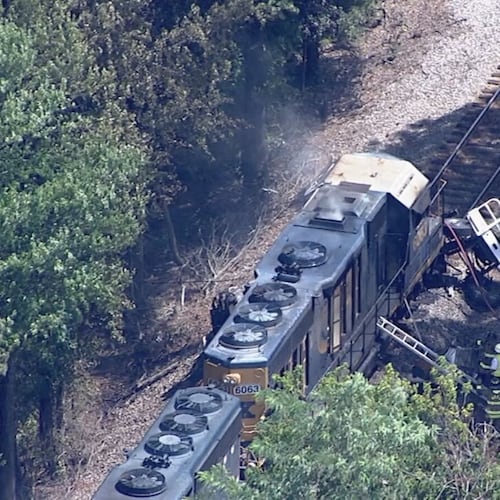Federal government maps predict in parcel-by-parcel detail where the water will travel when a megastorm hits.
Those maps anticipated that I-20 would remain high and dry, when flooding actually closed the highway down. The projections envisioned nothing more than a big puddle in the Food Depot parking lot in Austell, but what developed around the store was more like a lake.
And what the maps foresaw as a contained overflow of Cobb County’s Noonday Creek became a surge of water that filled the living rooms of homes blocks away.
Relying strictly on federal flood maps to determine whether a property merits flood insurance can lead to financial disaster for homeowners, The Atlanta Journal-Constitution found in an examination of the National Flood Insurance Program.
Many property owners whose homes were ruined had no idea that their standard homeowners insurance policy would not cover damage caused by a massive flood. Those who did understand the policies probably had no inkling that a property located outside the flood zone still faced a significant chance of getting hit.
“Who would think we need flood insurance, especially in landlocked Atlanta,” said Jennipher Ward, whose Austell home was swamped last week.
The current system that relies on homeowners to understand the complexities of flood risk doesn’t make sense, said Birny Birnbaum, a former insurance regulator who is a consumer representative to the National Association of Insurance Commissioners.
“It’s really analogous to telling a consumer, when you go get a health insurance policy it’s your responsibility to pick the illnesses you are insured for,” Birnbaum said. “It’s crazy.”
Companies don’t cover it
Insurance companies sell flood insurance for the federal government. But they have long refused to take on the risk of covering flood damage because of its potentially catastrophic nature. “The risk from an event like that is too great for any carrier to take on,” said Justin Tomczak, a spokesman for State Farm Insurance.
The federal government, which routinely sank millions into disaster recovery efforts after major flood events, decided to start selling coverage itself in 1968.
Almost anyone can buy flood insurance. But the only property owners required to buy it are those who have federally backed mortgages on property that lies within the official flood hazard area.
Some homeowners whose property lies outside the floodplain do buy the coverage. But most don’t, either because they assume their homeowners policy covers flooding or because they live outside the flood zone and assume they’re not at risk. By last year, the program had 5.6 million policies nationwide, including almost 15,000 in the 17 counties where federal disaster assistance was requested by the state of Georgia.
The average flood insurance policy costs $616 a year, according to the Federal Emergency Management Agency, a figure that includes policies on residential and commercial buildings. For properties outside the flood zone, the average annual cost is $333.
Local governments across the country must decide whether to participate in the National Flood Insurance Program. The vast majority do, although 66 communities across Georgia, most of them small cities outside the metro area, are not in the program.
When they join, local governments must agree to control development within their flood zones. In exchange, each community’s residents are allowed to purchase coverage from the program.
The maps that establish the official flood zones are the key to the program because home-owners and mortgage lenders rely so heavily on them to assess whether properties are at risk.
But in reality, the maps aren’t nearly as reliable as homeowners might want them to be. They are often hopelessly outdated, especially in a rapidly-developing place like Atlanta where new homes and parking lots can shift the flood zone’s boundaries.
Even when the maps are up- to-date, they measure the flood expected to result from a storm that has a 1 percent chance of occurring in any given year. Storms can exceed that expectation. And even in lesser rainfalls, floodwaters can travel beyond the official zones because drainage systems may be blocked or overwhelmed. When that happens the water backs up and can rush into the homes nearby.
About 25 percent of the flood insurance program’s claims paid every year are on properties outside the official flood zone, clear proof that the flood zones miss many houses at risk of damage.
Mapping experts are well aware of the shortcomings of the maps. But most homeowners haven’t a clue and follow the conventional wisdom that flood insurance is for the flood zone.
Tomczak, of State Farm, said only a “low percentage” of policyholders calling this week about flooding problems have flood coverage.
As estimated 2,000 people in Austell lost their homes or sustained significant damage in last week’s flood. But only 60 flood insurance policies were in force on Austell properties, federal data show.
Georgia updating maps
About five years ago, Congress recognized that many flood maps across the country were 20 years out of date and authorized a nationwide modernization effort.
Georgia is in the late stages of completing its modernization.
To try to make the maps more accurate, state and federal officials worked with local governments and conducted some new flood studies. But the federal money available for updating the data didn’t cover anything close to a comprehensive study of every stream and river.
The process of getting the maps approved is a lengthy one. In some Georgia counties new flood maps were approved so recently that some homeowners whose properties are now considered within the flood zone probably had no idea they were at risk until water started pouring into their homes last week.
The Georgia General Assembly considered a bill this year that would have required the state to notify property owners if updates to maps placed them in a flood zone. But the bill did not pass. Its sponsor, state Rep. Buddy Carter (R-Pooler), said he will try again next year.
J. Robert Hunter, the Consumer Federation of America’s insurance director, ran the federal flood insurance program during the 1970s when the program was new. At that time, Hunter said, he had a goal of updating the maps every few years to account for the changes development would create in the boundaries.
“Even then we were worried that development would always keep ahead of us and so our maps would always be a little low,” Hunter said.
When testifying before a Congressional committee in 2006, Hunter advised that if the maps are not kept updated the federal program should be ended. “The antiquated maps in use right now are a disgrace,” he testified.
In addition to underestimating which properties will flood, outdated maps also underprice the cost of flood insurance policies for properties built in a floodplain, because the risk of flooding is underestimated, Hunter said.
That means taxpayers end up bearing unnecessary extra costs for the property owners buying the coverage, who already enjoy a favorable rate because of public subsidies.
Zones of inaccuracy
It’s unclear now how far off the maps are for the Atlanta area. In some parts of town, the rainfall that came with the recent storm exceeded the so-called “100 year flood,” the event that has a 1-in-100 chance of occurring each year.
The U.S. Geological Survey concluded last week that rainfall in parts of Cobb and Douglas counties was so intense that it had only a 1-in-500 chance of occurring. With such an event, the flooding would be expected to extend beyond the official floodplain.
But less momentous events have also caused flooding to extend beyond the flood zone. Floods caused by Hurricane Dennis in 2005 damaged scores of homes in the Atlanta region that were not included in the floodplain.
Mapping experts all over Atlanta are anxious to compare the floodplain maps with aerial maps of the flooding that actually occurred. Ernie Smith, the GIS coordinator in Newton County, said the flooding appeared to remain close to the predicted flood zone around the Alcovy and South rivers. But around the Yellow River the flooding appears to exceed the expected boundaries, he said.
An AJC analysis found similar inconsistencies. In an area along I-575, south of Woodstock, for example, the AJC found that floodwaters exceeded the flood zone by as much as 500 yards in some places.
Given that flooding so often occurs outside the official floodplain, some experts believe it’s time for a change in the nation’s approach to flood coverage.
“There needs to be a system in which a lot more people are naturally moved into the flood insurance system,” said Robert W. Klein, an insurance expert at Georgia State University.
Birnbaum, the consumer representative at the National Association of Insurance Commissioners, said flood coverage should simply be a standard part of most homeowners insurance policies.
“It’s just a no-brainer,” said Birnbaum, director of the Texas-based Center for Economic Justice.
If insurance companies provided the coverage, they would make sure flood maps were up to date and that those buying coverage would pay what they should. That alone would discourage building in risky areas and would encourage investments in the sort of infrastructure that would limit potential flood damage. More people would get the coverage and the cost for everyone would go down, Birnbaum said.
The way it works now, insurers get paid by the flood insurance program to sell the policies and process the claims. But they have no risk of losses.
“The industry has got it so it’s not responsible for the claims, but it’s still able to profit from it,” Birnbaum said. “It’s absurd.”
-------------------------------------------------------
Risk: No flood insurance
Most people don’t have flood insurance, but a lot more of us should, experts say.
What you can do
Look at flood maps: Examine where your home is compared to areas of potential flooding on the Federal Emergency Management Agency's online maps . FEMA flood maps also are available for review at some local government offices, call your city or county for more information.
Check out the map date: Maps may be outdated and not reflect the growing flood risk caused by runoff from increased development in recent years. So don't assume you're safe if you're just outside the designated flood plain, Hunter said. "If you're just outside the flood plain, you can get flood insurance very cheap," he said.
Ask your insurer: "Hopefully people will see this situation as a wake-up call," said Justin Tomczak, a spokesman for State Farm insurance in Georgia. "The biggest mistake is thinking because it's not required you don't need it."
Learn more: To read more about federal flood insurance, including separating myths from facts, go to www.fema.gov/business/nfip .
Staff writers Aaron Gould Sheinin, Jennifer Brett and April Hunt, Alison Young and Database Specialist John Perry contributed to this report.
About the Author
The Latest
Featured

